Most animal lovers will have their hearts set on an African safari at least once in their lifetimes. Sure, there’s nothing quite like spotting a pride of lions in the Serengeti, or coming across a herd of elephants on the Masai Mara. But Africa isn’t the only place for a safari on this beautiful planet of ours! No matter where you live, or where you travel, there are incredible animals just waiting to be discovered. Heck, there’s even some great wildlife right here in the UK! I asked some of my fellow travel bloggers to share their favourite unusual wildlife destinations from around the world, and the animals you can see there.
Bears in Yellowstone National Park, USA – Jamie from Photo Jeepers
One of our favourite things to photograph in Yellowstone National Park, USA is the wildlife, especially the grizzly and black bears. There are no fences to limit movements so the animals can decide where they want to go. It’s important for people to give them the space and right-of-way to do so.

Too often we see people who don’t know what to do when they see a bear from the road in Yellowstone. Remember it is your responsibility to behave in a way that doesn’t put people, or the bear, at risk.
Here are some guidelines to ensure a safe and enjoyable experience:
- Do not stop in the road or block traffic. Park in a pullout to watch bears so other cars can pass. When you park, make sure your car is entirely out of the lane of travel.
- Stay in your car. If you can see and photograph the bear from your car, it’s the safest thing to do. If you choose to leave your car, stay close so you can get inside quickly if a curious bear begins to approach you.
- Do not feed bears or leave food where they can get it. When a bear has access to human food, even once, it can lead them to become aggressive toward people. Aggressive bears are often relocated or killed. Throw all garbage in bear-proof containers.
- If a bear approaches or touches your car, honk your horn and drive away to discourage this behavior.
- Do not approach bears, or follow them when they leave. The animals in Yellowstone are wild and unpredictable. Always stay at least 100 yards (91 m) away from bears. Use a telephoto lens or binoculars to get a better view or picture. Don’t even try to get a selfie with a bear!
- Give the bear space. Do not surround, crowd, or block a bear’s movement.
- Do not run or make sudden movements.
To see more of Jamie’s incredible photography, have a read of her post dedicated to Yellowstone in the Fall, or check her out on Facebook, Instagram or Pinterest.
>> If you’re interested in wildlife photography, read my top tips for better photos of animals here!
Red Sea, Egypt for Giant Moray Eels – Carly from Flight of the Educator
Marine wildlife is always amazing to see because of the beautiful colours and their exoticness since they live somewhere we can’t. I’ve been scuba diving for over a decade and on several continents, and I recently went diving in the Egyptian Red Sea and saw something I’ve never seen before… Giant Moray Eels.
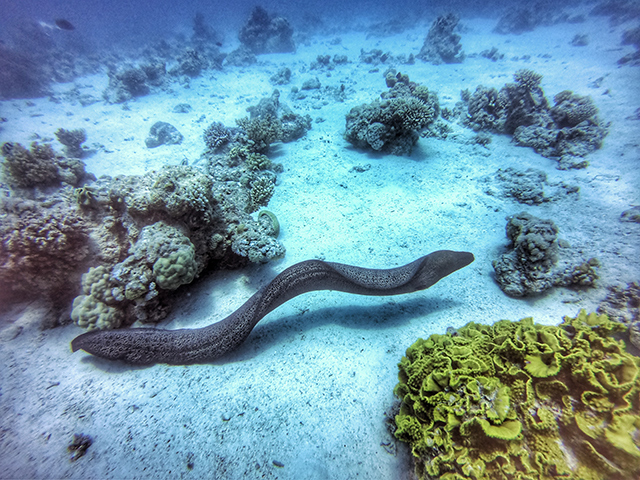
Sure, I’ve seen Moray Eels lurking in the nooks of reefs before but never like this. These truly lived up to their names because they really were giant! They can grow to be almost 10 feet long and 66 pounds! They are no longer small water snakes but look like flying underwater dragons undulating through the water. Usually eels are hiding, and these fellas were out swimming with all the confidence of a behemoth, and it was both scary and awe-inspiring. I went from the Egyptian city of Hurghada, and even though I’ve been to the Great Barrier Reef, I think I have to say that this was my favorite dive site! Read more of Carly’s adventures about diving in the Red Sea over on her blog, or check out her Instagram.
Duck-billed Platypus in Australia – Cat from Walk My World
The Duck-Billed Platypus is arguably the strangest animal in the world. When the Europeans first came across it, they were utterly confused as to how to categorise it. The description of the platypus to those back home in Europe was so bizarre that they thought it had to be a hoax. A mammal that lived in water with fur, webbed feet, a duck’s beak and venomous spines sounded about as likely as the Loch-Ness monster.
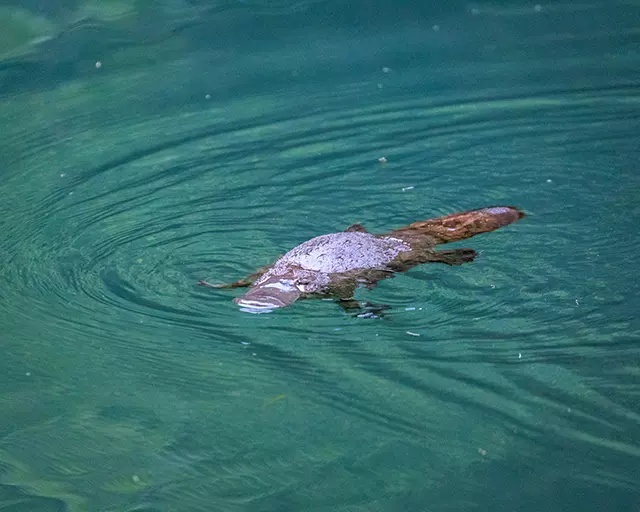
Platypus are rare and pretty hard to find in the wild. They are endemic only to Eastern Australia, notoriously shy and easy to spook. In the five years we lived in Australia, we only saw them a handful of times. It takes patience and sometimes a bit of luck, but if you know where to look you can definitely find them. They are most likely to be seen at dawn and dusk, and your chances increase if it is overcast.
Our first encounter was at Jenolan Caves in the Blue Mountains, New South Wales. Beside this major tourist attraction is a stunning blue lake, home to a couple of shy platypuses. On a cloudy evening, we waited for over an hour in the hope we’d see this elusive creature. Eventually a few ripples appeared and there it was, cruising through the water, its shape unmistakable.
Every 30 seconds it would dive and reappear over at the other side of the lake. We got lucky that the overcast conditions and complete silence (there was no one else around) made the platypus feel confident enough to appear from its den. It was an experience we will always remember. Have a look at Cat’s blog for more posts about things to do in the Blue Mountains.
Koalas in Australia – Hannah from Universal Jetsetters
Koalas have always been my favorite animals, so when we moved to Australia I was ecstatic. This is my chance to see one! I thought to myself. After many, many failed hikes and walks and actual days renting a car going out to try and find one in the wild, I finally found Gorge Wildlife Park.
Gorge Wildlife Park is an amazing wildlife sanctuary in the Adelaide Hills in South Australia. They rehabilitate animals and release them into the wild and take care of the ones that are unable to be released.
I don’t like zoos so I was sceptical about this place, but they do awesome things for rehabilitation and sustainability. They have a breeding program for populations that are at risk like meerkats, black-handed spider monkey, yellow-footed wallaby, cassowaries and more.
The highlight of the Gorge Wildlife Park? They have koalas! The first time I saw one, I legitimately cried. I was just so overwhelmed by their fluffiness and cuteness. It was awesome to see one so up close, since frequently in the wild they climb very tall trees where it’s hard to see them. If you want to see koalas in Australia, then I would highly recommend the Gorge Wildlife Park.

However, if you would prefer to see them in the wild, here’s a pro tip for you: Renmark! This rural town in South Australia is where I saw my first wild koala, who happened to be in a low-hanging branch on an island in the middle of the river. After getting tired from Kayaking, we decided to take a break and low and behold, there he sat! We subsequently saw several more on that trip.
Koalas are becoming rarer and rarer these days due to decreasing populations, so if you’re keen on seeing one then these are two great places to do so. Read more of Hannah’s adventures on her blog, The Universal Jetsetters or check out her Instagram, Twitter or Pinterest.
Royal Albatross in New Zealand – Sarah from Travel Breathe Repeat
The royal albatross is the largest seabird in the world, with a wingspan reaching 3.3 meters. Royal albatrosses live in the Southern Hemisphere, spend much of their lives at sea, and most nest on remote islands. So it’s a difficult bird to see. But there is one place you can try to spot them – at the Royal Albatross Centre at Taiaroa Head, the only mainland royal albatross breeding colony in the world. We were in the middle of our month-long New Zealand road trip spending a few days exploring the Otago Peninsula on the South Island. We participated in a wildlife tour and one of the highlights was the visit to the Royal Albatross Centre. Located at the tip of the Otago Peninsula, it was like we were standing at the edge of the world. The views were magnificent, and even further enhanced by the prospect of seeing these birds. We knew there was no guarantee we would see even a single bird because their ability to fly depends on wind conditions. They do not flap their (enormous) wings, but rather use wind currents to do what scientists call “dynamic soaring”. Via this impressive manoeuvre, royal albatrosses can fly at very high speeds for incredibly long distances. It was a pretty calm day, but we got lucky.
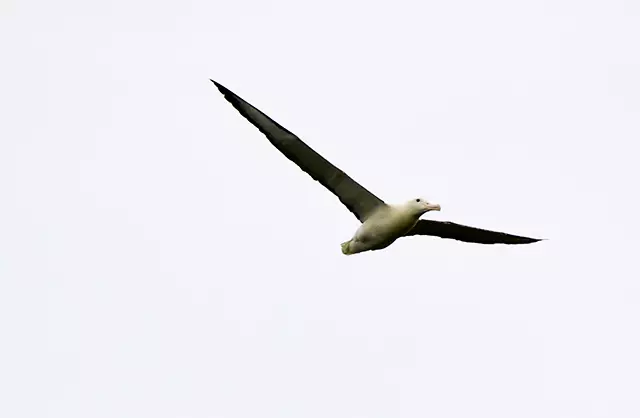
We watched in awe as at least four different birds flew back and forth between the cliffs around us. Seeing these regal birds soar through the air was truly a majestic sight, and one we’ll never forget. Read more of Sarah and Justin’s adventures on their blog, Travel Breathe Repeat, or have a look at their Twitter or Instagram feeds!
Deer in Nara, Japan – Melissa from Parenthood and Passports
Deer are some of the most beautiful, gentle, and graceful animals on the planet. In fact, the Japanese once called these peaceful animals “messengers of God”. And in Nara, Japan animal-lovers get a unique opportunity to get up-close and personal with wild deer in their natural habitat. The deer in Nara roam the streets and walkways right alongside the locals and tourists. Although the deer are wild they have become comfortable around people and will approach you, let you pet them, and at times even curl up and snuggle next to you. Although the Japanese no longer consider the Nara deer sacred, the animals are still considered a national treasure in Japan and are protected as such.

Nara Park, where the deer mainly live, is a public park and is free to visit. For a small fee, you can buy deer crackers from a street cart and feed them. It is a great experience for both adults and children. But be cautious when approaching the deer, especially with young children. Although the deer are accustomed to being around people, they may still buck, kick, or bite. They will also try to eat anything they think is food, that includes loose clothing, a small handbag, a map, or train ticket hanging out of your back pocket or purse. But if you use caution, are vigilant when around the deer, and respect the fact that these beautiful creatures are still wild, you can have an incredibly memorable encounter with the deer in Nara. Read more of Melissa’s travels over on her blog, Parenthood and Passports.
Wild Horses on Easter Island – Ketki from Dotted Globe
Easter Island is undoubtedly famous for its stone statues or the Moai but not many people know about the wild horses that have the run of the island. These horses were brought to Easter Island by Catholic missionaries in the early 19th century. They flourished on the island, more than the Moai themselves, and currently, are said to even outnumber the Rapa Nui people.
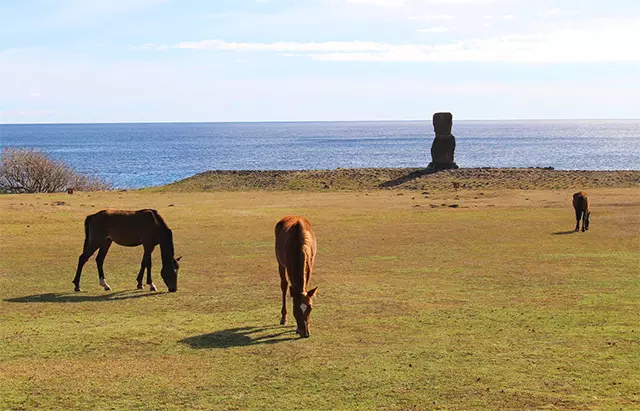
The wild horses are literally everywhere. We first encountered them running gracefully along the rocky coastline while we were driving along the road. We saw them grazing near the crater lake of the quarry at Rano Raraku. They were just a few feet from the Moai located on the inner slopes and I was slightly envious of their ability to go where visitors could not. We also encountered them while driving at night when the horses crossed the road right in front of our car. Watching them sway their thick tails and graze in front of the eroded Moai on the northern coast was by far my best way to spend time on Easter Island. The horses perfectly complement the wild and remote nature of Easter Island and are salient reminders of its colonial past. Read more of Ketkis’ adventures on her blog, The Dotted Globe.
***We couldn’t leave Africa out completely though, could we? Here’s a few of the best…
Cape Cross Seals in Namibia – Elaine & David from Show Them The Globe
Stories of shipwrecks and seals led us up to the Skeleton Coast in Namibia where the treacherous coastline has long been a graveyard for unsuspecting ships. The Cape Cross Seal Reserve sits along the Skeleton Coast and is home to over 100,000 seals, one of the biggest seal colonies in the world. The Cape Cross Seal Reserve is an incredible spectacle and there are thousands and thousands of seals as far as the eye can see.
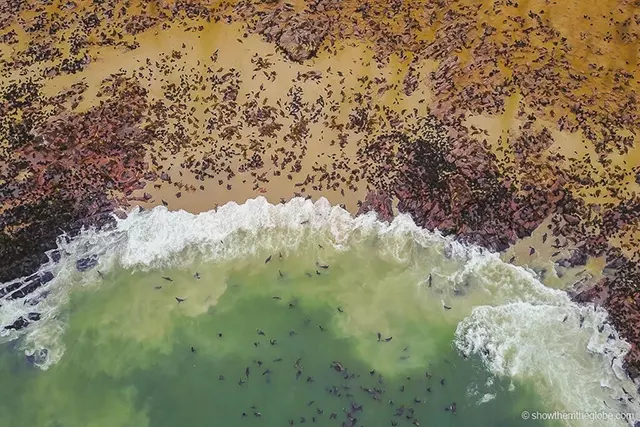
As we arrived at Cape Cross the seals met us in the car park where a few loitered around the parking area and lounged across the picnic tables! The first thing we noticed was the smell which was both unpleasant and breathtaking and we grabbed our scarves to give us some breathing space until we got used to the aroma. We oohed and ahhed at the plentiful and very cute seal pups being minded by their mums and watched as the adults fought over their tiny patches of land and dived into the sea from the rocky beach in search of food – the seals survive on a diet of fish from the Cape. It’s even possible to spot some jackals or brown hyenas lurking in the shadows, ready to pounce and take a tiny seal cub from its unsuspecting mother. As well as its seal population the Cape has a fascinating history. In 1486 the Portuguese explorer Diego Cao was the first European to arrive on its shores while searching for a sea route from India to Africa. He erected a cross to stake Portugal’s claim on the territory and a replica still stands today. Take a look at Elaine and Dave’s blog, Show Them the Globe, for more!
Lilac Breasted Roller in Botswana – Larch from The Silver Nomad
Bouncing over the savanna in our jeep in the Okavango Delta, a glint of turquoise and blue streaking across the sky immediately caught my attention. I blinked and it was gone. I scanned the sky but the elusive bird escaped me. I soon became absorbed in a herd of zebra, but the little turquoise bird was still on my mind. Suddenly I caught sight of another one sitting patiently in a tree, a kaleidoscope of cream, white, purple, green, black, pink, tan, blue and turquoise, as if it had been let loose in a paint factory. “What is that bird?” I eagerly asked Tom, our safari guide. “A lilac breasted roller,” was the simple reply and with that I was smitten!

The Lilac Breasted Roller (Coracias caudatus) is the national bird of Kenya and unofficially of Botswana. Said to be monogamous, the rollers only produce one clutch of 2-4 white eggs per year.
Preferring open grasslands or woodlands, the rollers are non-migratory, but can lead a nomadic life searching out food during droughts. They tend to hang about at the top of trees for a vantage point to sweep down on their prey. They are carnivorous and are known to eat insects as well as lizards, small rodents, amphibians and even small birds.
Every time I saw a roller our driver would patiently stop so I could take more photos. I didn’t quite manage to get a shot of one on the wing with their outstretched turquoise wings tipped with royal blue and the elegant tail feathers with black streamers but it is an excuse to go back to Botswana to see them again.See more of Larch’s wildlife encounters on her blog, The Silver Nomad.
White Rhinoceros in South Africa – Christine from The Travelling Pinoys
The white rhinoceros is the largest extant species of rhinoceros family and also one of the largest mammals in the world. Despite their size, they are a non-aggressive animal by nature, the most sociable of the rhino species and they also have poor eyesight, which makes them susceptible for poaching. There are only two kinds of white rhinos – the Southern white rhinos and the Northern white rhinos. The Northern white rhinos are already considered functionally extinct as the last known male Northern white rhino died in Kenya early this year. This only leave 2 female Northern white rhinos that won’t be able to reproduce naturally. The Southern white rhinos – although a successful story of being brought back from being nearly extinct – are still under nearly threatened status. This means unless there is an urgent effort to save them, we might also lose them.
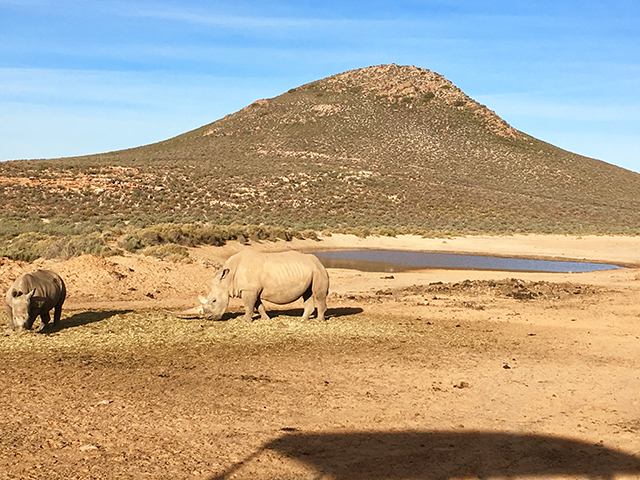
The rhinos are known for their big horns that are said to have healing properties in Asian medicine. According to an article published by The Atlantic, Rhinos horn now cost more than gold in the black market in Asia. Despite the laws and heavy penalties for poaching, this reason alone makes it attractive for poachers.
The first time I saw white rhinos was when I joined my colleague for a conservation effort awareness program through his vlog. It was organised by the game drive administrators in Aquila Game Reserve and local travel companies in Western Cape, South Africa. The trip was enlightening and mesmerising. Seeing these gentle giants felt like being taken to a pre-historic world. But at the same time, it’s heartbreaking to know that these gentle giants survived millions of years, but could not survive the selfishness of mankind. If we don’t start protecting them, we might only see Rhinos in pictures in the future. Read more about Christine’s adventures in South Africa and Cape Town over on her blog, The Travelling Pinoys.
>> To see more of the best wildlife encounters in South Africa, have a read of my post here!
***
We hope this post goes to show that there’s plenty of fish in the sea animals in the wild, in destinations you might not have expected! What are your favourite unusual wildlife destinations, and where have you had the most unexpected wildlife encounters? I’d love to hear your ethical stories in the comments!
Like this? Pin me for later >>

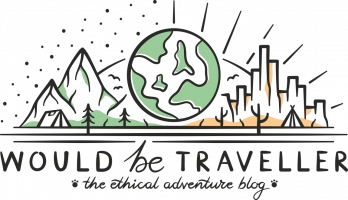
WOW!, So many more animal destinations to add to my bucket list. I loved that bit on the little Platypus! So cute. Wildlife travel is always part of my agenda when I go travelling so it’s great to add some more of the world stranger animals into the mix. Thanks for the article!
It’s the best feeling seeing animals in the wild – I recently saw my first ever koala in the wild, simply by the side of the road drinking from a puddle!! Such a refreshing read, love this and so many more destinations for the bucket list!
That lilac breasted roller looks like it flew out of a Monet painting! Absolutely love this post and your appreciating for these beautiful animals!
Great list! So many animals to see, and the key is to do so without disrupting their environment.
Glad to see platypus made it on the list! It has got to be the oddest & cutest animals on earth. I have just recently spotted my first platypus in the wild and I almost had tears in my eyes from the excitement.
I had NO idea that there were horses on Easter Island! As if I needed another reason to go!